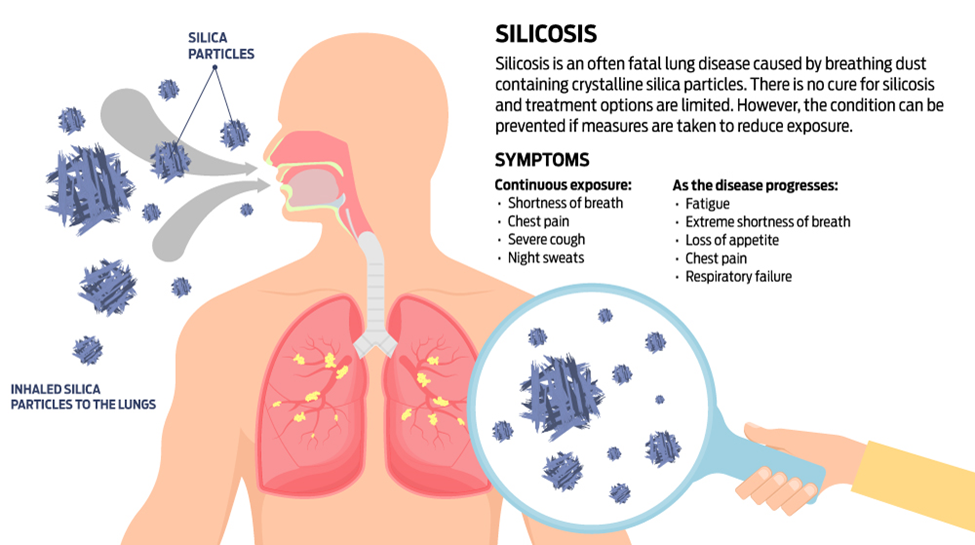The nurse is taking the history of a client with occupational lung disease (silicosis). The nurse should assess whether the client wears which item during periods of exposure to silica particles?
Mask
Gloves
Eye Protection
Gown
The Correct Answer is A
A. Mask:
Silicosis is a lung disease caused by inhaling crystalline silica dust. The primary preventive measure during exposure to silica particles is wearing a mask or respirator. This helps to reduce the inhalation of silica dust, protecting the respiratory system.
B. Gloves: Gloves are typically worn to protect the hands and skin and are not directly related to preventing inhalation of airborne particles.
C. Eye Protection: While eye protection is important in certain occupational settings, it does not specifically address the inhalation of silica particles.
D. Gown: Gowns are worn for protection against contamination but are not directly related to the prevention of occupational lung diseases such as silicosis.

Nursing Test Bank
Naxlex Comprehensive Predictor Exams
Related Questions
Correct Answer is A
Explanation
A. "Did you have rheumatic fever as a child?"
Rheumatic fever is an inflammatory condition that can affect the heart, especially the heart valves. Rheumatic fever is a known risk factor for the development of valvular heart disease. Asking about a history of rheumatic fever helps identify a potential cause for valve malfunction.
B. "Do you have a family history of valve problems?"
Family history can be relevant in understanding genetic predispositions to certain cardiac conditions. While it may contribute to the overall assessment of cardiac risk, it may not be as directly linked to valve malfunction as a history of rheumatic fever.
C. "Do you have a history of MRSA?"
MRSA (Methicillin-resistant Staphylococcus aureus) is a type of bacterial infection and is not directly associated with valve malfunction. This question may be relevant for other aspects of the client's health but is not specific to ruling out cardiac issues related to valve malfunction.
D. "What over-the-counter medications do you take?"
While knowing the medications a client takes is important for a comprehensive assessment, asking about over-the-counter medications may not be as directly related to ruling out cardiac issues related to valve malfunction. It is more relevant for assessing potential interactions or effects on cardiovascular health.

Correct Answer is D
Explanation
A. Lie in a low Fowler’s or supine position:
Lying in a low Fowler's or supine position may worsen respiratory distress and compromise oxygenation. It can reduce lung expansion and increase the work of breathing, especially in patients with pneumonia. This is not a recommended position for individuals with respiratory issues.
B. Increase oral fluids unless contraindicated:
Increasing oral fluids is generally a good practice, especially in respiratory conditions like pneumonia. It helps thin respiratory secretions, making them easier to clear. However, this alone may not address copious tracheobronchial secretions. Suctioning may be needed to effectively remove excess secretions.
C. Increase activity:
Increasing activity may be beneficial for some patients, but it might exacerbate respiratory distress in others, especially if they are already experiencing increased work of breathing. The appropriateness of increasing activity depends on the specific condition and the patient's overall stability.
D. Call the nurse for oral suctioning as needed:
This is the most appropriate choice. If the client is experiencing increased work of breathing due to copious tracheobronchial secretions, calling the nurse for oral suctioning is an intervention aimed at maintaining a clear airway and alleviating respiratory distress. Regular suctioning may be necessary to assist the client in managing secretions effectively.
Whether you are a student looking to ace your exams or a practicing nurse seeking to enhance your expertise , our nursing education contents will empower you with the confidence and competence to make a difference in the lives of patients and become a respected leader in the healthcare field.
Visit Naxlex, invest in your future and unlock endless possibilities with our unparalleled nursing education contents today
Report Wrong Answer on the Current Question
Do you disagree with the answer? If yes, what is your expected answer? Explain.
Kindly be descriptive with the issue you are facing.
